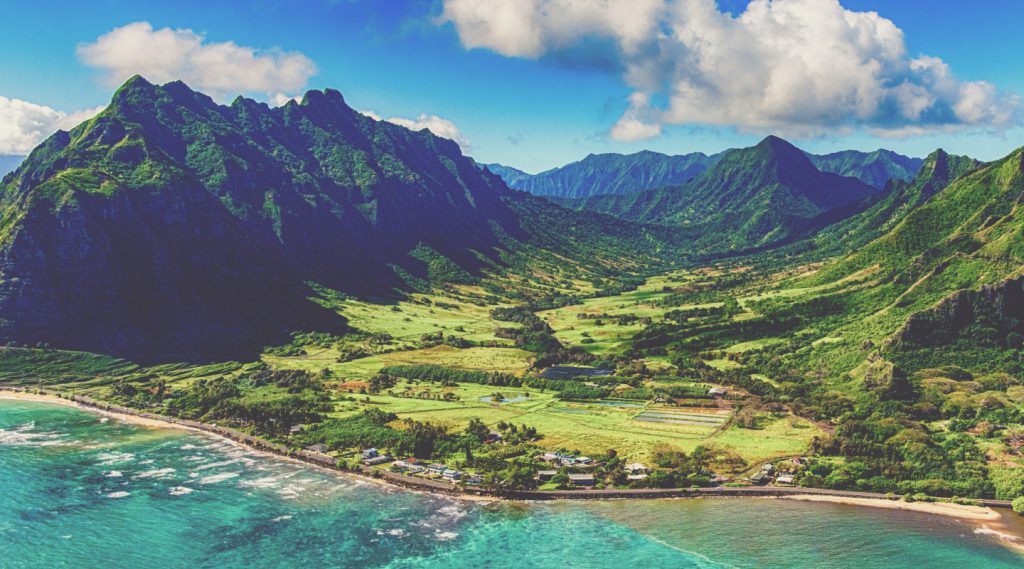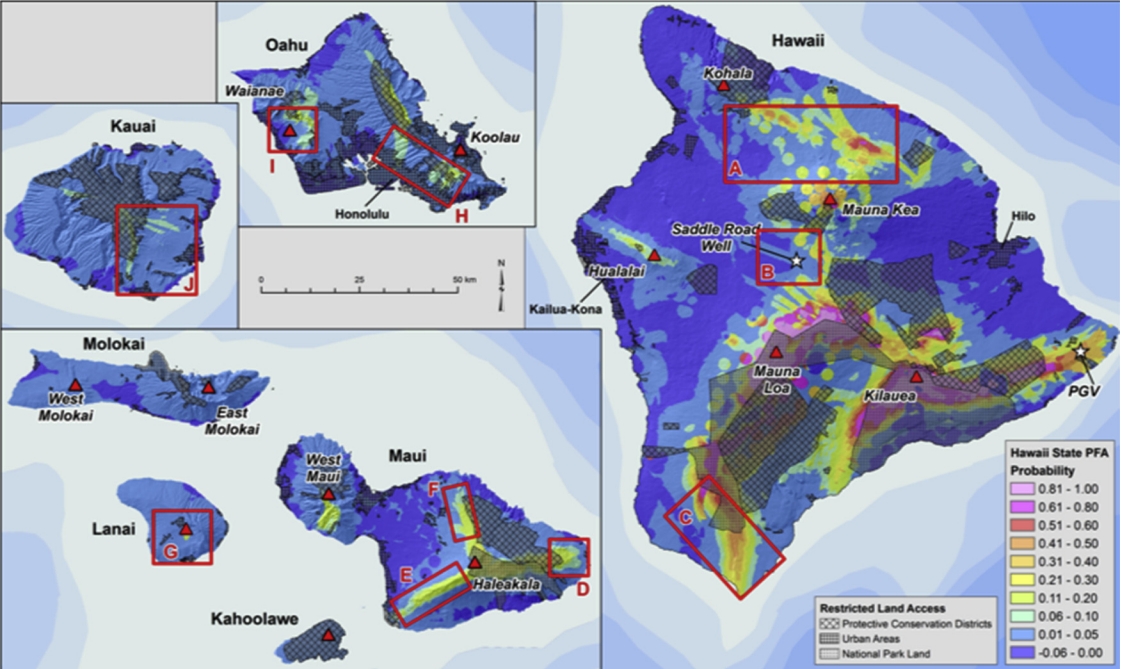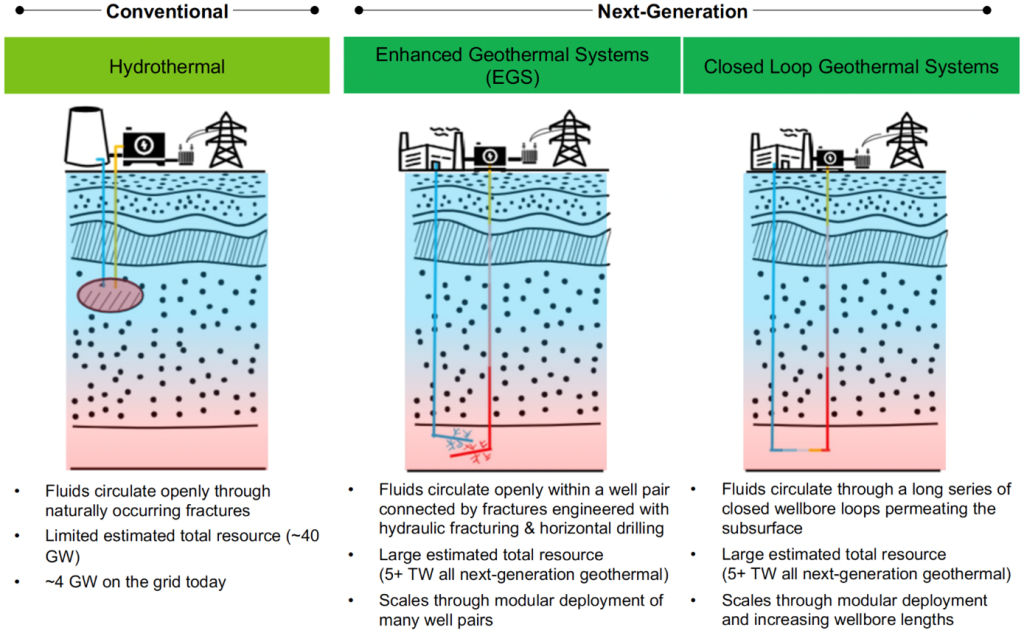
GEOTHERMAL
What is Geothermal Energy?
Geothermal energy is the Earth’s heat, which can be harnessed for electricity generation or direct uses like heating and cooling. In Hawaiʻi, the main application of geothermal energy is electricity generation, which is possible where subsurface heat, permeability, and transport fluid create an “optimum geothermal play.” As a firm, dispatchable, low-carbon, local resource, geothermal energy is accessed through wells that tap steam, hot water, or geothermal fluid, which is used to turn turbines and drive generators, creating electricity.
Understanding Geothermal as a Public Trust Resource
A “public trust resource” refers to natural resources such as land, water, minerals, and wildlife held in trust by the government for all citizens. In Hawaiʻi, the Public Trust Doctrine is enshrined in the constitution and law, extending beyond water to land, air, minerals, natural beauty, and Native Hawaiian cultural practices. Article XI, Section 1 of the Hawaiʻi Constitution states: “For the benefit of present and future generations, the State and its political subdivisions shall conserve and protect Hawai’i’s natural beauty and natural resources, including land, water, air, minerals and energy sources, and shall promote the development and utilization of these resources in a manner consistent with their conservation and in furtherance of the self-sufficiency of the State. All public natural resources are held in trust by the State for the benefit of the people.”
The doctrine mandates the state to protect public natural resources while considering the traditional and customary rights of Native Hawaiians. It recognizes both the public’s right to use trust resources and the private, traditional, and customary rights in those resources, with a presumption in favor of public use, access, and enjoyment. Ultimately, it requires balancing protection with maximum beneficial use, recognizing that these obligations are not mutually exclusive.

History of Geothermal in Hawaiʻi
For decades, geothermal energy has been one of the most environmentally responsible methods for generating large-scale power. It can play a crucial role in phased transition plans toward cleaner fuel and electricity generation, potentially with energy storage such as hydrogen. It offers greater long-term reliability than other renewable sources, providing baseload capacity. Most importantly, it is a public trust resource and must be approached with care and reverence if Hawai‘i is to expand its use.
HSEO has played a pivotal role in advancing geothermal energy for over a decade. Through strategic partnerships with the University of Hawaiʻi’s Groundwater and Geothermal Resource Center (HGGRC), the U.S. Department of Energy (USDOE), and the National Renewable Energy Laboratory (NREL), HSEO has led efforts to understand the regulatory landscape for responsible development. Some of this research is outlined in our State Energy Resource Library.
Geothermal Energy Today
The Kīlauea East Rift Zone is home to the 38-megawatt Puna Geothermal Venture (PGV) plant and is the only region in Hawaiʻi with geothermal development. PGV is in the process of upgrading its technology, from 12 generators to 3, increasing its capacity to 54 MW. Other areas show suitable attributes, and surface research suggests potential outside Kīlauea, but limited deep-well studies leave their resources largely unknown. Generally, geothermal probability decreases north along the older islands, but areas such as Oʻahu, with high demand, may hold plausible resources pending further subsurface study.
A Path Forward
Why should the resource be developed?
The state’s energy transition to 100% renewable energy by 2045 will require more than the intermittent sources of energy that solar and wind provide. Firm and dispatchable resources, such as geothermal, are paramount to our energy reliability and grid stability. Geothermal energy, as a public trust resource, has the potential to provide the reliability that Hawaiʻi’s energy ecosystem requires.
What work is HSEO doing?
Research
In 2024, Governor Green allocated $5 million from the Coronavirus State Fiscal Recovery Fund for SEO to initiate a slim-hole resource characterization program to improve our understanding of Hawaiʻi’s geothermal potential. Slim-hole characterization is required to identify geothermal resources, and a good overview of possible resources can be developed using geophysical surveys, subsurface stress analysis, and groundwater chemistry. The University of Hawaiʻi is conducting research using slim hole drilling on Maui to gather, more information on the resources available and possible locations for geothermal energy development.
Community Outreach
The Hawaiʻi State Energy Office has committed to fostering a healthy community conversation about geothermal energy by introducing education and engagement programs. By providing improved access to information on geothermal energy, the state energy office intends to improve communications and foster community input. The energy office has also convened a Geothermal Working Group to evaluate the regulatory and policy landscape surrounding geothermal energy in Hawaiʻi.
Our approach involves the engagement of Paʻakai Communications in an extension of the HSEO Clean Energy Wayfinders program to ensure community engagement occurs within the larger context of achieving state RPS and decarbonization goals. This outreach involves sensitive conversations with the intent to improve access to information and community empowerment in determining Hawaiʻi’s energy future, including consideration of geothermal energy.
Community Input
The community plays a key role in the decision-making process and the success of all renewable energy projects in Hawaiʻi. HSEO recognizes the importance of prioritizing community engagement, education, and collaboration throughout the research and planning processes of a project to ensure the project meets the community’s needs and priorities.
Geothermal Working Group
House Concurrent Resolution (H.C.R.) 58 House Draft (H.D.) 1 was passed by the Thirty-third Hawaiʻi State Legislature during the 2025 Regular Session, and requests that HSEO convene a Geothermal Energy Working Group to evaluate the regulatory and policy landscape surrounding geothermal energy in Hawaiʻi. The Working Group is to be made up of designated representatives from relevant State and local government offices, representatives from relevant industry stakeholders, and other invited members. In addition, the H.C.R. requests that HSEO submit a report of its findings and recommendations, including any proposed legislation, to the Legislature no later than 20 days prior to the convening of the 2027 Regular Session.
Requirements
H.C.R 58 H.D. 1 states that the working group will be convened with the overarching premise of having a community-inclusive process to evaluate the role of geothermal development in Hawai’i. This group is tasked with identifying a clear development pathway that aligns with state policy, environmental stewardship and cultural sensitivity.
The working group will identify any regulatory, permitting, and policy challenges affecting the state; review best practices from other jurisdictions, such as New Zealand; assess geothermal energy’s potential expansion and its role in supporting energy resilience and affordability; and provide recommendations to the legislature on policy and regulatory reforms necessary to establish a clear and efficient pathway for geothermal energy in Hawaiʻi.
Geothermal Energy Resource Studies

Used with permission. Image sources: Lautze, Ito, G., Thomas, D., Frazer, N., Martel, S., Hinz, N., Tachera, D., Hill, G., Pierce, H., Wannamaker, P., Martin, T., (2020). Geothermics, 86, Article 101798. Play Fairway analysis of geothermal resources across the State of Hawai‘i: 4. Updates with new groundwater chemistry, subsurface stress analysis, and focused geophysical surveys Results of the initial geothermal play fairway probability analysis for the State of Hawai‘i. Probabilities of a geothermal resource are colored. Areas with restricted land access are shown in stippled and crosshatch patterns (e.g., National Park lands, protective conservation districts, and urban areas). Red boxes outline areas proposed for subsequent study. Red triangles indicate the calderas of the main shield volcanoes. White stars mark the locations of the Saddle Road well and Puna Geothermal Venture (PGV).
Hawai’i Play Fairway Reports
The Hawai’i Playfairway reports were commissioned by the US Department of Energy in conjunction with the US Office of Science and the University of Hawai’i. These reports were the first if their kind conducted in the state of Hawai’i since 1985. Its purpose was to conduct assessments to find hydrothermal resources which sit below the surface and characterize sources in rift-zone settings. These studies concluded with recommendations of areas for further exploration, a roadmap for additional exploration activities, and an updated resource assessment.


